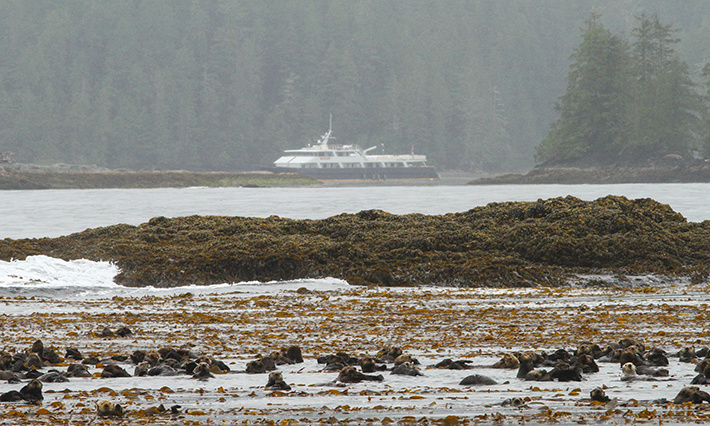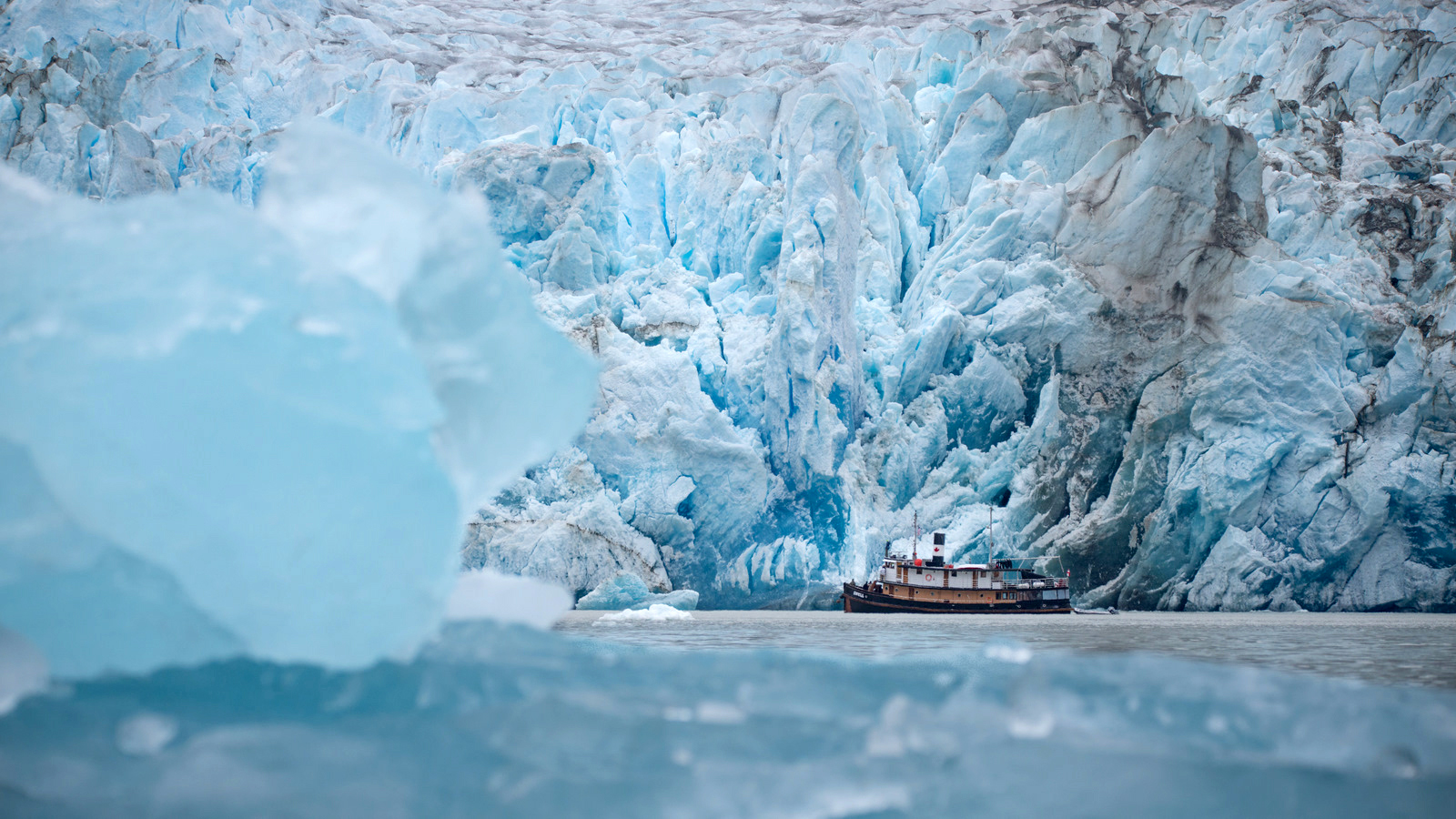
This is the “Serengeti of the sea”: rich in wildlife, famed for its summer sailing, complex whale community, and ancient human cultures. It is the best place on earth to see killer whales and humpback whales. It is rich in seabirds, porpoises and other ocean life. On forested islands and on the water, humans have also thrived for millennia, and this trip will introduce you to the ancient and modern First Nations culture. Learn more here.
Picture this: you are standing on the 90-foot tugboat Swell, wooden rail under hand, seas slide past, eight feet below your eyes.
The day begins with a visit to a tidewater glacier, watching thousand-year-old ice crumble spectacularly into a turquoise sea. Amid the rumble, your group watches from zodiacs. There’s a hiss and crackle of tiny ice chunks all around as they melt into the sea, while terns swoop above, calling out.
Your expedition guide pulls a clear bergy bit into the boat and take it back to Swell for drinks. In the afternoon, you come across bubble-net-feeding humpback whales gulping up schools of herring. Your group lingers, listening through Swell’s onboard hydrophone to their ethereal feeding calls, bursting from the depths.
This excerpt from Maple Leaf Adventures from a day on expedition in Tongass National Forest, Alaska, paints a picture of what summer can be like—right here on our wild west coast.
With the official start of spring, travel planning for summer is well underway. The season also arrived with a welcome easing of testing requirements, making the exotic parts of BC and Alaska an attractive option for travellers the world over.
It’s not hard to see why. Adventure travel, like a west coast safari, offers the thrill of new places, cultures and experiences, plus the quality of guiding, and seamless hospitality that we seek on international safaris and expedition cruises. In this story, we explore west coast destinations that are far-flung from summer crowds, made accessible by boutique expedition company Maple Leaf Adventures.
Where The Wild Things Are
These summer trips are weeklong journeys, of 8 to 24 guests, led by local guides and mariners in the fjords and island beyond our towns and highways. There are no roads, so the safari moves on coastal yachts, going ashore each day.
Cruising from the edge of the continental shelf off northwest Vancouver Island, to the aptly named Whale Channel on the mainland coast, to Alaska’s tidewater glaciers, trips explore intact, world-class rainforest ecosystems. Summer showcases marine mammals at their most active such as humpback whales, orcas and sea lions. Seabirds flock and forage and, in Alaska, brown bears gather for salmon.
Adventures Beyond The Roadmap
This is wild geography without roads. Guests move between locations and live and dine aboard one of Maple Leaf’s three expedition yachts: a 92-foot sailing ship, Maple Leaf; a 90-foot tugboat, Swell; or a 138-foot catamaran, Cascadia. These lovingly maintained ships access a world closed to bigger ships – due to their nimbleness, guides’ local knowledge, the company’s special access permits, and their long-standing relationships of trust with coastal First Nations.
Cultural Wonders, Here In Canada
There’s more to the coast than its rugged natural beauty. Steeped in history, BC and Alaska are home to dozens of Indigenous nations and coastal towns. Sharing a meal, a walk, a conversation with locals, guests are able to feel a natural connection to coastal culture.
Contribute to Citizen Science
On trips like this, there is a natural intersection between tourism and science. Stewards and scientists are often part of the guiding crew, and the company is developing programs that guests can particpate in to contribute to long-term and ongoing research such as tracking whales, seabirds and marine debris.
Where do we sail?
- Great Bear Rainforest (Photo: Jeff Reynolds)

Explore 6.4 million hectares of fjords and islands, including the world’s largest remaining intact temperate rainforest. Dramatic coastlines, glacier-cut fjords and spider-like estuaries support an abundance of marine life such as whales and orcas, which arrive in these waters to feed on fish and krill. The summer is a peak time for exploring beaches, waterfalls, and river estuaries. Learn more here.
- Alaska’s Southwest (Photo: Jeff Reynolds)

Almost anything you do in Alaska could be called an “adventure”—but this small group expedition really kicks it up a notch. Whether navigating icebergs by zodiac or enjoying some of the world’s best brown bear viewing in remote backcountry locations, an Alaskan tugboat expedition give you the opportunity to personally connect with the natural and cultural history of the world around you, each day becoming more in tune with the rhythm of the coast. Learn more here.
- Vancouver Island’s Wild Side (Photo: Kevin Smith)

Vancouver Island combines untamed shoreline, dense old-growth forest, and coastal mountains to offer up one of the most diverse ecosystems you’ll find anywhere. It’s become a beacon of international travel, but its wild and hidden northwest corner promises to offer even locals a surprise. From the glacial refugium of Brooks Peninsula to Solander Island’s puffin colonies, this special itinerary by catamaran is for those seeking island adventure beyond the norm. Learn more here.
- Broughton Archipelago (Photo: Jeff Reynolds)




